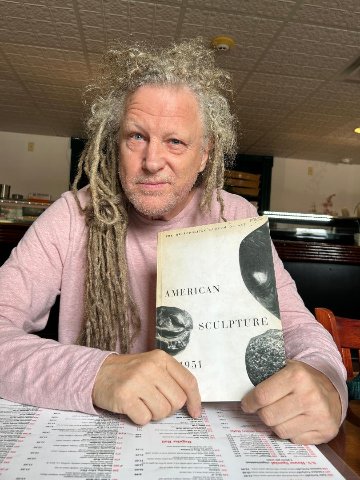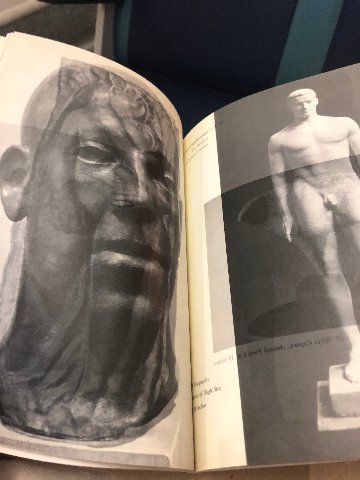Artist and Rastafarian Peter Dudek
Publishing a Limited Edition Book
By: Charles Giuliano - Jul 18, 2023
Artist and Rastafarian, Peter Dudek, stopped cutting his hair in the 1980s.
“Is it a Samson thing” I asked during a sushi lunch in North Adams.
He chuckled softly as he often does during our witty conversations about the arts and living in the Berkshires.
“It was growing out in dreds,” he said. “I didn’t know what to do about it so I just let it do its thing. When I wash it I have to ring it out like a wet rag.”
With his brother, the chef, and a partner he is part of the team for Bascom Lodge on Mount Greylock. He works three days a week, organizing events and speakers, as well as lending a hand “putting out fires.”
During days off during the summer we meet from time-to-time.
I was surprised to learn that it’s the fifteenth summer of a 25-year lease. Overall the project has been a great success but with speed-bumps. Like a recent rainy Sunday when nobody was hiking. There have been a lot of those days this summer but he told me that the coming week is fully booked. The Saturday night jazz suppers are well attended.
When we first met prior to Bascom, Peter with Maggie Mailer, was involved with the Storefront Artists Project in Pittsfield. They promoted pop up galleries and studios in the then moribund downtown. There was national publicity for their programming.
Now nearing retirement he teaches as an adjunct at Hunter College and the School of Visual Arts. That was my lot for many years and we often discuss its foibles. But that gives him access to talented students and advanced technologies.
That was instrumental in creating a limited edition of an artist’s book. In the Duchampian Dada tradition it fits the category of an assisted readymade.
Some time ago he showed me a proof of a facsimile copy of a Metropolitan Museum of Art catalogue “American Sculpture” (1951). With time the images had bled into each other. I commented that they were “palimpsests.” (An object or area that has extensive evidence of or layers showing activity or use.)
We exchanged books. My “Annisquam: Pip and Me Coming of Age” for his unique object. Peter’s book is printed in an edition of 200.
I asked how true to the original his book is. “Very” was the answer with a discussion of the blacks and ink process then and now. It’s interesting to note that Duchamp made facsimiles and editions of his original found objects.
What follows is the press release as well as artist’s statement.
Non-Mystic Monk Editions
Contact: Monika Sosnowski
Phone: 917-686-4444
Email: monikasosnowski@gmail.com
Website: https://www.peterdudek.com/
The book launches will be at Familiar Trees in. Great Barrington and BravinLee programs (they spell programs with a small p) in New York City.
AMERICAN SCULPTURE 1951
Non-Mystic Monk Editions is delighted to announce the publication of Peter Dudek’s American Sculpture 1951, a conceptually re-envisioned facsimile-like artist book of an old exhibition catalog by the same title. The original catalog was produced by the Metropolitan Museum of Art to accompany a large group exhibition of contemporary sculpture in 1951. The show included 94 artists out of which 49 had their artworks featured in the catalog.
Dudek, a sculptor himself, first found and purchased the catalog back in 2018 from a used book store in New York City. Naturally drawn to the subject matter, Dudek was impressed by the exquisite quality of the photogravure-like, black & white reproductions and the book’s aged physicality. The word “PRESS” was stamped in upper right corner of the front cover and the otherwise blank back cover had handwritten notes in pencil.
Looking closely at the sculptures in the catalog, Dudek was at first surprised at
the predominance of figurative pieces. Although the American art scene in those days is now known for its embrace of abstraction, you wouldn’t know it from the catalog’s images. The curator’s foreword claimed that sculpture was less willing to abandon realism than painting at that time and why so few abstract works were showcased.
Most intriguing was the way this seemingly simple, soft-cover 7 x 10-inch book of around 60 pages, had aged. Inside, images had slightly bled from one side of the page to the other, appearing as beautifully alluring apparitions. Curious about the possibilities of using these ghostly afterimages as a starting point for a new project, Dudek began scanning pages to use as source material. Unexpectedly the intensity of the scanner’s light read three, sometimes even four, pages deep. These additional layers further reconfigured the original sculptures.
Fascinated by this poetic seepage Dudek understood the catalog not as a static document, but as an ongoing performance, one that, over time, reconfigured artworks. The catalog - this book - was a creative act unto itself, and through the process of aging it had reimagined history. Thus, Dudek realized a new American Sculpture 1951 was needed. One that further elaborated an ongoing creative and entropic ritual.
In addition, this project will include limited edition archival prints of pages from American Sculpture 1951.
Artist Statement about American Sculpture 1951
I collect old art exhibition catalogues, especially on sculpture. I like the ink quality and the rich blacks of books printed 50 or more years ago. American Sculpture 1951 was a large group show of sculpture at the Metropolitan Museum of Art. Although the American art scene of those days is now known for its embrace of abstraction you wouldn’t know it from the catalog. Aside from a handful of abstract pieces, figuration dominated the pages. The curator claimed that sculpture was less willing to abandon realism than painting.
Most interesting to me, however, was the way the catalog had aged. Images from one side of the page bled to the other. This was not a static document, entropy and physical deterioration had reconfigured art works; it was a creative act unto itself, an ongoing performance.
I scanned the book, and the intensity of the scanner’s light read three or four pages deep, further merging and modifying individual sculptures. These new images suggested a new catalog, a new American Sculpture 1951, one that would participate in and further elaborate this ongoing entropic ritual.




